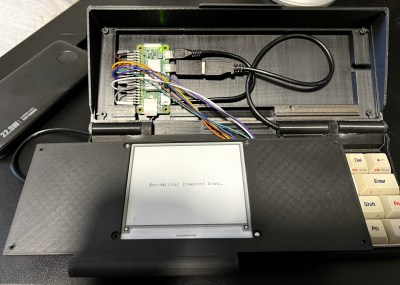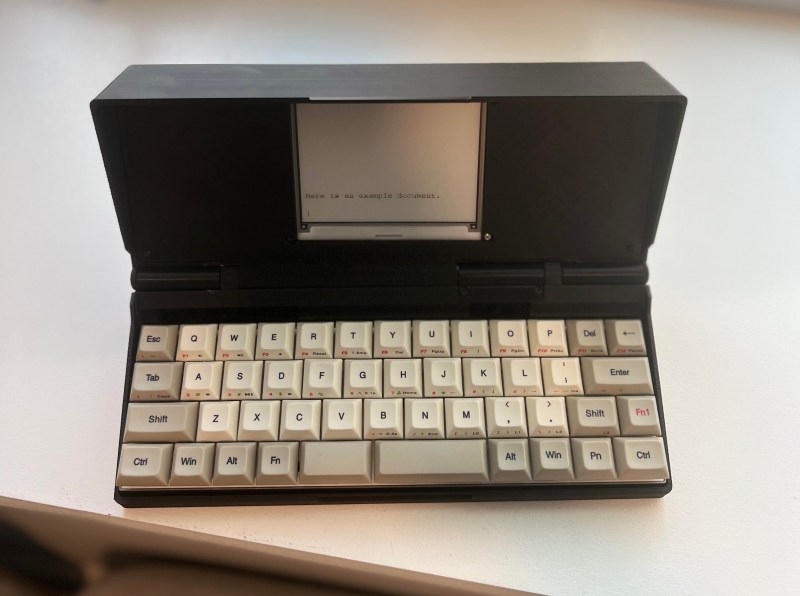As great as full-blown desktop computers may be for web surfing, gaming, and what have you, they are theaters of distraction when it comes time to write. And while there are machines out there purpose-built for writing, the price tags run awfully high for what they are, which is essentially a microprocessor handling a keyboard and an E-ink display.
 So, why not build one yourself, then? That’s the idea behind the Zerowriter, which, as you may have guessed, is based on the Raspberry Pi Zero. The Zero 2 W to be exact: [zerowriter] says that the extra power over the original Zero is quite useful.
So, why not build one yourself, then? That’s the idea behind the Zerowriter, which, as you may have guessed, is based on the Raspberry Pi Zero. The Zero 2 W to be exact: [zerowriter] says that the extra power over the original Zero is quite useful.
In addition, there’s a 4.2″ Waveshare E-ink display and the Vortex Core 40% keyboard inside the 3D-printed enclosure. The design is based on the Penkesu computer, although in the Zerowriter, the Pi sits behind the screen instead of underneath the keyboard. [zerowriter] built an application on top of the Waveshare demo program that’s easy to use and modify.
The price tag for this build comes in around $200, which is a fraction of similar commercial products. Most of the cost is in this particular keyboard, although 40%s are, broadly speaking, not cheap. We would love to see someone make a keyboard for this.
Looking to make something a bit bigger? Be sure to check out the MUSE.

















Looks alright. I hope that the e-ink can update fast enough to not be totally unusable (sub-50 ms or so is my guess, probably very possible with localized updates)
With the modified LUT that I also have used it is 330mS.
The screen borders are, for me, a distraction.
Hope you never need to type numbers and don’t use much punctuation.
Eh, at least it *can* create the characters, even if you need to press multiple keys. Old typewriters sometimes didn’t have a 1 key, instead you used the lowercase L.
Maybe someone needs to build a modern day equivalent of the old-school “word processor”.
Technically Astrohaus’s Freewrite line does this, but frankly? It’s style over substance. I’m not saying it’s a bad product, just that the way they’ve gone about things and just as tellingly how they’ve advertised…. leaves a sour taste in my mouth.
You can always pick an alphasmart neo up on ebay for like… twenty bucks.
Cool construction. The “cheap” screen seems really disproportionate even to the small keyboard, though. Would the build be significantly more complex with two or three of them?
The proverbial fraction in the price is a funny element. If sticking to existing keyboards as a base, one could probably get a bigger keyboard paired with a bigger screen and spend not that much more of money on the build. Of course, if you want the device to be tiny above everything else, the situation changes somewhat. What’s going on with the project formerly known as beepberry?
On a personal level, I’ve had some similar ideas regarding use of e-paper displays, but having a distraction-less device doesn’t really help me – if I have a craving for distractions, it’s not like I can leave my smartphone outside of the town, and if I don’t, I can maximize a particular window on a laptop and ignore everything else in the world. It’s interesting how psychological barriers vary.
nice keyboard but not for writer code or conlangs
You could write conlangs, just stick to 26 letters.
I can already see two distractions, to which others have already alluded: the tiny, slow screen and the esoteric, multi-layer keyboard. Props for the nice, tidy build, though.
A 60% would be a better experience as a writer going from a normal keyboard. This? You’re gonna have a learning period.
I would be distracted by neck pain, inability to read off this shitty small screen and cramped keyboard. But that just me. The ergonomics of this thing are shit.
It may be easier to set up a typewriter and digitize with OCR on photos taken with a phone (which should be pretty successful, when the typeface is so regular, but corrections would be annoying) but the latency would probably be the thing I’d be more distracted by if I used it than the ergonomics.
Not a bad idea but I think the choice of the screen isn’t all that great. I will one day build something like this but with a bigger screen and a Linux distro that just boots into Vim.